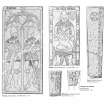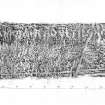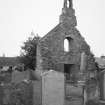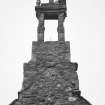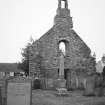Insch, High Street, St Drostan's Parish Church
Church (18th Century)
Site Name Insch, High Street, St Drostan's Parish Church
Classification Church (18th Century)
Alternative Name(s) Old Church Of Insch; Old Parish Church
Canmore ID 18140
Site Number NJ62NW 20
NGR NJ 63334 28146
Datum OSGB36 - NGR
Permalink http://canmore.org.uk/site/18140
- Council Aberdeenshire
- Parish Insch
- Former Region Grampian
- Former District Gordon
- Former County Aberdeenshire
Old Parish Church (St Drostan's), renovated late 18th century. Only dark gable survives of kirk, but with fine bellcote of 1613, richly carved with tiny spiky finials. Medieval graveslab (13th century?) at base of gable, inscribed: ORATE PRO ANIMA RADULFI SACERDOTIS (Pray for the soul of the priest Radulfus). Originally recorded as having 'contained some interesting carvings in wood'.
Taken from "Aberdeenshire: Donside and Strathbogie - An Illustrated Architectural Guide", by Ian Shepherd, 2006. Published by the Rutland Press http://www.rias.org.uk
NJ62NW 20.00 63334 28146
NJ62NW 20.01 63354 28135 Churchyard
For present parish church (NJ 6310 2820), see NJ62NW 58.
(NJ 6333 2814) Church (NR)
OS 6" map, (1959)
The old church of Insch, dedicated to St Drostan (Scott 1915-61), and gifted to the Abbey of Lindores before 1195 by David, Earl of Garioch. Stephen Mason was minister in 1567 (Simpson 1949). It was repaired in 1793, but declared unsafe about 1830, and the present church built in 1886. Only the W gable remains, with a bellcote dated 1613, (SDD 1960-) the latter giving rise to the local belief that the church was built then (NSA 1845).
In the graveyard, together with a 1600 gravestone, is the Radulfus stone, a medeival tombstone. It was found some years before 1866 whilst demolishing a house on the N side of the church and probably commemorates Radulfus, chaplain of the Bishop of Aberdeen between 1172 and 1194. It is the earliest surviving medieval monument "in our area" (Simpson 1943).
H Scott et al 1915-61; W D Simpson 1943; 1949; New Statistial Account (NSA) 1845; SDD 1960-; A Jervise 1875-9; Name Book 1867.
1613. Only west gable with belfry and 1706 Albert Gely bell extant.
G Hay 1957.
Only the W gable, 2 storeys high, with the 1613 bellcote remains, with c. 2.0m of the N and S walls. It appears to have been a 17th-18th century structure. The burial ground is still in use. The dedication could not be confirmed.
The Radulfus stone is preserved against the outside of the W gable.
Visited by OS (RL) 5 March 1969.
Church [NR] (remains of) [NAT]
Grave Yard [NAT]
OS 1:2500 map, 1976.
Press and Journal 25 November 1961.
(GRC/AAS ground photography listed).
NMRS, MS/712/58, visited 16 November 1977.
The remains of the former parish church of Insch stand in its burial-ground on the E side of the town of Insch (NJ62NW 42). The visible portion of the church has been reduced to the WNW gable and the stumps of the NNE and SSW sides; it measures 6.2m in internal breadth and the random rubble walls are 1.05m in thickness. The gable incorporates a rectangular-headed doorway, and, above it, an arch-headed window, both of which splay internally. A scarcement at a height of 2.2m on the internal face of the gable indicates the former existence of a loft in the WNW end of the church. The apex of the gable is surmounted by the ashlar plinth of an elaborately decorated bellcote, which is dated 1613 and bears the initials M I L around a shield on its S side.
Two medieval burial monuments have been placed against the outer face of the WNW gable. The first, which measures 1.05m in height, is the head and torso of the effigy of a knight dating to the late 13th- or early 14th century. It is heavily weathered, and the figure's face has sheered off, but traces of detail survive along its more sheltered sides; the figure is clad in mail armour, with a coif, a surcoat, a belt, and a large shield. Beside the effigy there is a grave-slab of red sandstone measuring 1.8m in length by 50mm in thickness and tapering in breadth from 0.43m to 0.34m. At its wider end a wedge-armed cross has been incised within a circle. Running along the slab is an incised inscription reading: ORATE:PRO:ANIMA:RADULFI:SACERDOTIS:.
The burial-ground is rectangular on plan and contains many 19th-century headstones. On the date of visit all of the recumbent monuments were obscured by snow.
Visited by RCAHMS (IF, JRS), 21 February 1996.























































